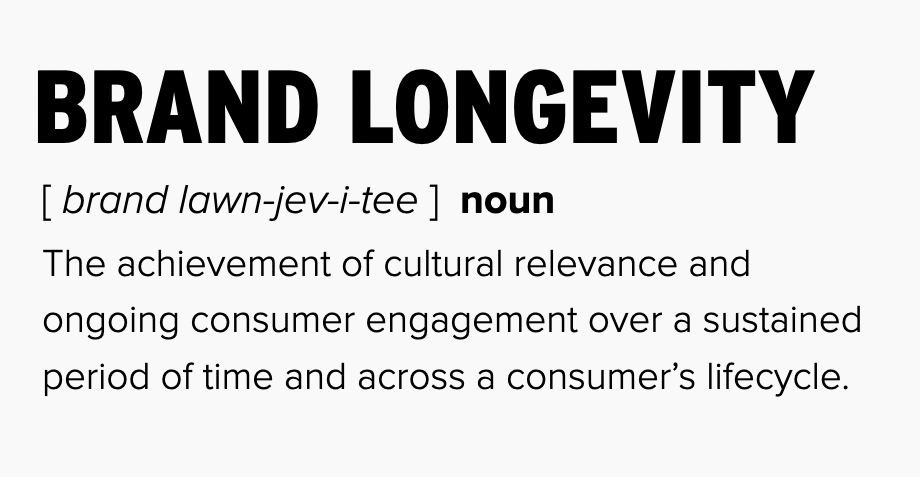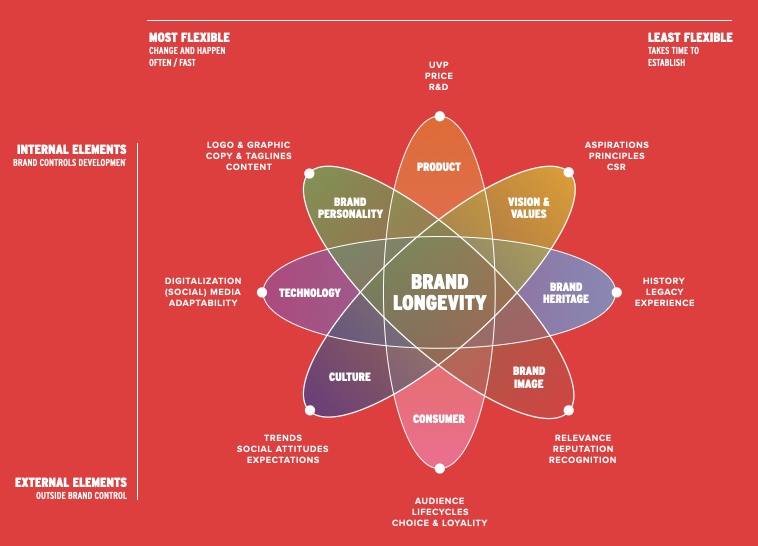Brands across categories have made significant changes to the way they are operationalized, positioned, and communicated to consumers in response to the tumultuous events of 2020. In some cases, brands have made major shifts or pivots to remain relevant to consumers, while others have remained fixed. This brings up a critical question for marketers: do brands that pivot to reflect the current cultural moment experience greater favorability than those that stay true to their brand heritage and identity?

The answer to the question is complicated. It depends on the brand and context, and involves an emerging field of marketing research exploring Brand Longevity.
At Brownstein — an agency built on more than half a century of experience developing and marketing brands — we have taken it upon ourselves to apply this legacy towards better understanding what makes brands survive and thrive, both through long periods of change and through pivotal moments in history.
Among the questions we will be exploring this year, through proprietary research and future publications, are: What makes some brands retain the loyalty of their consumers throughout their lifetime? How do some brands know when to pivot in the face of changing currents in culture and technology? And: how can a brand preserve its legacy while engaging new consumers in a globalized and connected world?
We know that these are some of the most pressing questions facing our clients in 2021, as they navigate an economy and society deeply altered by a global pandemic, recession, and social unrest. For that reason, we have put together a deep dive into Brand Longevity in order to introduce you to a new way of thinking about your brand — one that might help inform critical decisions in the months to come.
Our research on Brand Longevity is not unprecedented. In a paper published in 2019 in the Journal of Consumer Research titled “License to Assemble: Theorizing Brand Longevity,” the authors describe the topic as part of a critically important, though unexplored, field of study in the future of marketing.
In the study, a team of marketing researchers based in the UK tackled the subject of brand emergence: when a brand becomes something more than its constituent brand elements, even as these elements change and as context changes. Through an analysis of archival brand-related data — including films, books, marketing materials, press commentaries, and reviews — researchers defined socioeconomic and cultural contexts that surround a brand at a particular moment in time as nests. According to the paper, the heritage of a brand depends on its many iterations within these nests and how they form a cohesive whole bigger than each part.

The paper uses a great case study to illustrate brand longevity: James Bond. We all have the sense of who James Bond is. His identity and clichés have remained consistent and recognizable throughout the franchise’s 50+ year history. Nonetheless, Bond is transported to fresh and exotic locales in each film, with a new Bond villain, Bond car, and with new gadgets and adventures that constantly refresh his brand and re-engage his audience. Even as these elements change, however, they too fall within recognizable archetypes and fit within a broader, successful formula and brand.
The study found that brand revitalization in the marketplace is “a balancing act between continuity and change,” which requires constant decision-making based on an understanding of brand actions, consumer actions, and cultural identity. Therefore, it is critical for brands not only to understand the elements most important to their image and reputation, but also those which can adapt or be refreshed in future iterations.
Following the findings of this study, as well as other recent examples engaging with the topic, we sought to further our understanding of brand longevity by asking the question: What are the Bond Cars, Bond Villains, and Bond Gadgets of today’s brands?
In order to do so, Brownstein has developed The Brand Longevity Ecosystem, a model that maps out brand longevity and its constituent elements in several dimensions. It is a bird’s eye view of what makes a brand what it is, and shows how its elements influence and are related to each other.

In Brownstein’s model, elements such as Brand Personality, Product, and Vision & Values are represented towards the top of the chart because they are Internal Elements that the brand can control. Towards the bottom, External Elements such as Culture, Consumer, and Brand Image encompass what is mostly out of the brand’s control. Elements such as Technology, History, and Legacy straddle the line between Internal and External control, as they are influenced, defined, and exercised both by the brand and the external world.
On the X axis, elements are arranged from most to least flexible in a similar manner, with elements like Culture and Technology being among the most rapidly changing and flexible, and elements such as Brand Heritage and Vision & Values being the least flexible and most unchanging.
By understanding the dynamics of pivots across brand elements, we can seek to achieve an understanding of how changing particular brand elements affects a brand as a whole.
The Brand Longevity Ecosystem is a model of brands as we understand them today, drawn from decades of marketing knowledge, academic studies, and lived experience. In the future, we hope to build upon this model to create a framework and tool which can allow marketing leaders to make executive decisions that will ensure the longevity of the brands they manage.
For now, it is a useful guide for understanding the elements of a brand in a holistic way that is true to how integrated marketing campaigns are carried out in the real world: involving a 360-degree consideration of the advertising, public relations, and digital channels along with internal and external factors.
Stay tuned for more useful findings and explorations on Brand Longevity, and don’t forget to subscribe and share our newsletter with your colleagues and friends so they can be in the know as well!